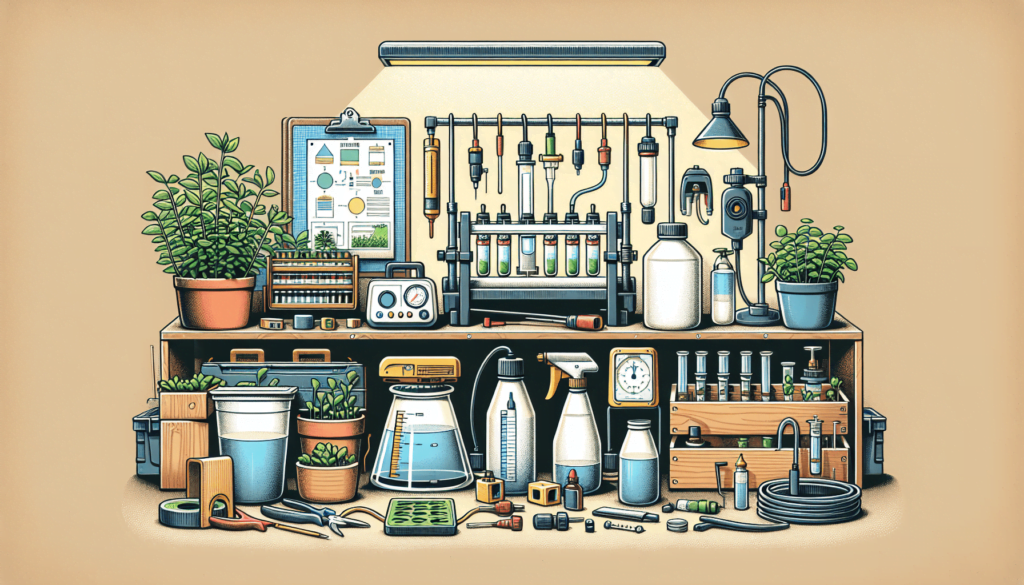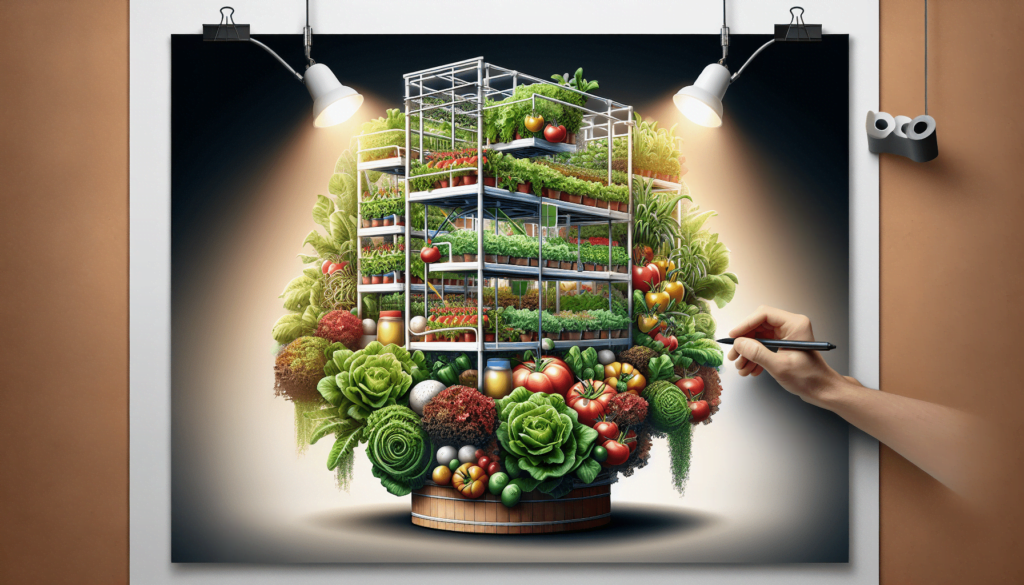Plunging into the world of hydroponics can be an exciting endeavor. The fact that it allows us to grow our favorite plants indoors without soil and promises faster results than traditional gardening makes it all the more fascinating. In this article, we’ll unveil the best plants that you can seamlessly incorporate into your DIY hydroponic setup, guiding you to make the most of this modern gardening method. Whether you’re just starting out or have considerable experience, this information packed piece will surely benefit you.
Understanding Hydroponics
When looking at hydroponics, it’s crucial we first lay a foundation by understanding what it is. Hydroponics is a method of growing plants in a water-based, nutrient-rich solution, bypassing the need for soil. The root system of the plant is supported using an inert medium such as perlite, Rockwool, clay pellets, peat moss, or vermiculite.
Definition of Hydroponics
Hydroponics comes from the Greek words ‘hydro,’ meaning ‘water,’ and ‘ponos,’ meaning ‘labor.’ In essence, hydroponics is the science of soil-less gardening. It involves growing healthy plants without the need for a traditional soil medium and using mineral nutrient solutions instead.
Different Types of Hydroponic Systems
There’s an array of hydroponic systems, but we’ll talk about six primary types: Wick System, Deep Water Culture (DWC), Nutrient Film Technique (NFT), Ebb and Flow (Flood and Drain), Aeroponics, and Drip Systems. Each has its own way of supplying plants with water, oxygen, and nutrients, and your choice will depend on variables like available resources, personal interest, and the scope of your project.
Benefits of Hydroponics
The advantages of hydroponics are numerous. For starters, the growth rate of a hydroponic plant is 30-50 percent faster than a soil plant. This is mainly because the plants have direct access to the nutrients they need to grow. Also, the technique allows for space-saving, as many more plants can be tucked into the same space as traditionally grown crops.
Preparation for Hydroponic Set-up
Before you start your hydroponic journey, there are things to consider, components you’ll need, and the process to set up your system.
Factors to Consider When Setting Up a DIY Hydroponic System
Considering the system’s location is vital. Bright light, temperature, and easy access for maintenance are essential. Other key considerations might include the potential need for additional artificial lighting and the cost of start-up and ongoing operational expenses.
Essential Hydroponic System Components
Essential parts of a hydroponics system include a growing tray, a reservoir, a submersible pump, tubing to distribute water, an air pump, air stone, and a timer. To support plant root systems, you will need some form of a medium to hold the plants in place and nutrient solution for nourishment.
Setting Up the Hydroponic System
Setting up the system involves installing the parts in their right places, following the instructions provided by your system’s manufacturer. If it’s a DIY setup, ensure all the components are strategically positioned for optimal functioning.

Lettuce
Lettuce is a top choice for beginners due to its fast growth rate and easy maintenance.
Ideal Conditions for Growing Lettuce Hydroponically
Lettuce grows best in cooler temperatures, around 50-70°F. Compact fluorescent lights (CFLs) work well for lettuce due to their low heat output.
Steps to Grow Lettuce Hydroponically
First, place your lettuce seed in a structurally stable growth medium. Once a root network emerges, transfer to your hydroponic system. After transplant, your nutrient solution should be lower in nitrogen, higher in potassium, and have intermediate levels of phosphorous.
Maintaining and Harvesting Hydroponic Lettuce
You’ll want to regularly check the pH and EC (nutrient concentrations) of your system and make sure the system remains clean. Harvest lettuce as a whole plant or just the outer leaves to allow the rest of the plant to continue growing.
Spinach
Hydroponically grown spinach is a great addition to your setup. It’s one of the quickest growing leafy greens, and its high nutrient value makes it a popular choice.
Ideal Conditions for Growing Spinach Hydroponically
Spinach thrives in cooler, non-humid conditions (between 45-75°F) but can tolerate a wide range of climates.
Steps to Grow Spinach Hydroponically
First, plant seeds in a rockwool cube or another medium and move them to your system once roots have emerged. It’s important to keep the nutrient solution balance optimized and lighting appropriate to ensure optimal spinach growth.
Maintaining and Harvesting Hydroponic Spinach
Maintain the pH and nutrient levels of your system and keep an eye out for pests or diseases. Spinach can be harvested as a whole plant or as individual leaves.

Kale
With their high nutrient content, kale is an excellent option for hydroponic gardening.
Ideal Conditions for Growing Kale Hydroponically
Kale requires full sunlight or equivalent artificial light and temperatures between 60-70°F.
Steps to Grow Kale Hydroponically
Similar to lettuce and spinach, plant seeds in a medium and transfer to your hydroponic system once roots emerge.
Maintaining and Harvesting Hydroponic Kale
Temperature, nutrient balance, and pH levels should be regularly monitored. Harvest leaves from the bottom of the plant to encourage continual growth.
Strawberries
Strawberries are more of an intermediate hydroponic project but totally worth the effort for fresh, home-grown strawberries all year round.
Ideal Conditions for Growing Strawberries Hydroponically
Strawberries prefer temperatures between 60-80°F and plenty of light.
Steps to Grow Strawberries Hydroponically
For strawberries, it’s recommended to start with a bare root plant or a stolon from a mature plant. Once planted in your system, be sure to provide plenty of light.
Maintaining and Harvesting Hydroponic Strawberries
Monitoring of the system is vital. Aim to harvest strawberries when they are ripe and fully colored.
Herbs
Many herbs thrive in hydroponic systems, and because they don’t require a lot of space, you can grow a large variety in a small area.
Common Herbs Suitable for Hydroponic Cultivation
Common herbs such as basil, cilantro, dill, and mint are all excellent choices for hydroponic growth.
Ideal Conditions for Growing Herbs Hydroponically
Herbs tend to prefer temperatures between 65-70°F. They don’t require as much light as veggies, making them a good option for indoor herb gardens.
Steps to Grow Herbs Hydroponically
Plant seeds in a pre-soaked growth medium, place them in your system, and monitor nutrient and pH levels.
Maintaining and Harvesting Hydroponic Herbs
Keep an eye on your herb plant’s overall health and trim regularly to encourage bushier growth.
Peppers
Though requiring a bit more patience to grow hydroponically, peppers can bear fruit for years when properly cared for.
Ideal Conditions for Growing Peppers Hydroponically
Peppers love the warmth and grow best at temperatures around 70-85°F.
Steps to Grow Peppers Hydroponically
Peppers are preferably grown from seedlings rather than seeds. Ensure that they receive plenty of light and their nutrient solution is well balanced.
Maintaining and Harvesting Hydroponic Peppers
Regular pruning can help promote branching and higher yields. Harvest your peppers when they reach your desired color.
Tomatoes
These sun-loving fruits add versatility to your hydroponic garden.
Ideal Conditions for Growing Tomatoes Hydroponically
Tomatoes favor a warmer climate, between 70-80°F, and require a lot of light.
Steps to Grow Tomatoes Hydroponically
It’s common to start tomatoes from seeds, although seedlings are also a good option. Place them under adequate light and maintain proper nutrient levels.
Maintaining and Harvesting Hydroponic Tomatoes
Prune lower leaves and dead branches for healthier growth. Harvest tomatoes when they’ve reached their full color and give slightly to thumb pressure.
Advancing Your Hydroponics Skills
As you continue your hydroponics journey, keep learning, join a hydroponic community, and try new plants.
Continuous Learning Resources
Books, online articles, YouTube videos, and webinars provide endless information that can help advance your hydroponic skills.
Joining a Community of Hydroponics Enthusiasts
Join local groups or online communities of like-minded gardeners. You can share experiences, explore ideas, and learn many new tips and tricks.
Researching and Trialing New Plant Varieties
Implement your skills and knowledge to grow different plant varieties. It broadens your experience and allows you to enjoy a diverse range of fresh produce right from your home, regardless of the season.
Forum
Got something to share or a question to ask? Jump in and start a conversation! Whether it’s tips, advice, or just sharing your experiences, we’d love to hear from you. Don’t be shy—your input could inspire or help someone else!- This forum has 1 topic, and was last updated 10 months, 2 weeks ago by .
- Topic
- Voices
- Last Post
- You must be logged in to create new topics.
Register Here
Forum
Got something to share or a question to ask? Jump in and start a conversation! Whether it’s tips, advice, or just sharing your experiences, we’d love to hear from you. Don’t be shy—your input could inspire or help someone else!- This forum has 1 topic, and was last updated 10 months, 2 weeks ago by .
- Topic
- Voices
- Last Post
- You must be logged in to create new topics.


